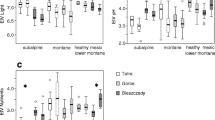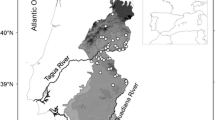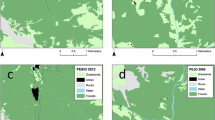Abstract
Vast grasslands are found in the walnut-fruit forest region of southern Kyrgyzstan, Middle Asia. Located above the worldwide unique walnut-fruit forests and used for grazing, they play a pivotal role in the mixed mountain agriculture of local farmers. Accordingly, these pastures are subject to an increasing utilization pressure reflecting the changing political and social conditions in the transformation process from a Soviet republic to an independent state. A first detailed analysis of mountain pasture vegetation in the Ferghana Range answers the following questions: What are the main plant community types among Kyrgyzstan’s mountain pastures? What are the main environmental gradients that shape their species composition? Which phytogeographical distribution types are predominant? How does grazing affect community composition and species richness in these grasslands? Species composition was classified by cluster analysis; underlying environmental gradients were explored using DCA. A dataset of 395 relevés was used for classification, and a subset of 79 relevés was used in a DCA to analyze the correlation between vegetation, environment, and grazing impact. The investigated pastures were classified into four distinctive plant communities. The site factors altitude, heat load, inclination and grazing impact were found to be the major determinants of the vegetation pattern. A significant overlap between floristic composition and structural and spatial properties was shown. The majority of the species pool consisted of Middle Asian endemics and Eurosiberian species. However, disturbance-tolerant species played a significant role with respect to species composition and coverage of the herbaceous layer in vast areas of southern Kyrgyzstan’s mountain pastures. In general, an intense grazing impact is clearly reflected by both species composition and structural variables of plant communities. The highly diverse and unique ecosystem is modified by an increasing utilization pressure. In order to maintain vital processes and functioning of this valuable ecosystem — in both economical and ecological terms -, it is indispensable to adopt appropriate pasture management strategies.
Similar content being viewed by others
Abbreviations
- DCA:
-
Detrended Correspondence Analysis
- IV:
-
Indicator Value
- ISA:
-
Indicator Species Analysis
- NPMR:
-
Non-parametric Multiplicative Regression
- CV:
-
Coefficient of Variation
- SD:
-
Standard Deviation
References
Asner GP, Elmore AJ, Olander LP, et al, (2004) Grazing systems, ecosystem responses, and global change. Annual Review of Environment and Resources 29: 261–299.
Atlas Kirgizskoy SSR 1987. Atlas of the Kyrgyz SSR. Moscow. (In Russian)
Baur B, Cremene C, Groza G, et al (2007) Intensified grazing affects endemic plant and gastropod diversity in alpine grasslands of the Southern Carpathian mountains (Romania). Biologia 62: 438–445.
Beer R. Kaiser F,. Schmidt K, et al (2008) Vegetation history of the walnut forests in Kyrgyzstan (Central Asia): Natural or anthropogenic origin? — Quaternary Science Reviews 27: 621–632
Borchardt P, Schmidt M, Schickhoff U (2010) Vegetation patterns in Kyrgyzstan’s walnut-fruit forests under the impact of changing forest use in post-soviet transformation. Die Erde: 141: 255–275
Braun-Blanquet J (1964) Pflanzensoziologie. — 3rd ed. — Springer, Vienna.
Connell JH (1978) Diversity in tropical rain forests and coral reefs. Science 199: 1302–1310.
Cowan PJ (2007) Geographic usage of the terms Middle Asia and Central Asia. Journal of Arid Environments 69: 359–363.
Czerepanov SK (1995) Vascular plants of Russia and adjacent states. Cambridge University Press, Cambridge.
Davletkeldiev AA (ed.) 2007. Red data book of Kyrgyz Republic. — 2nd ed. — Bishkek.
Díaz S, Lavorel S, McIntyre S, et al (2007) Plant trait responses to grazing — a global synthesis. Global Change Biology 13: 313–341.
Dufrene M, Legendre P (1997) Species assemblages and indicator species: The need for a flexible asymmetrical approach. Ecological Monographs 67: 345–366.
Eastwood A, Lazkov G, Newton A (2009) The Red List of Trees of Central Asia. Fauna & Flora International. Cambridge.
Epple C (2001) A vegetation study in the walnut and fruit-tree forests of southern Kyrgyzstan. Phytocoenologia 31: 571–604.
Faith DP, Minchin PR, Belbin L (1987) Compositional dissimilarity as a robust measure of ecological distance. Vegetatio 86: 57–68.
Fernandez-Lugo S, de Nascimento L, Mellado M, et al (2009) Vegetation change and chemical soil composition after 4 years of goat grazing exclusion in a Canary Islands pasture. Agriculture Ecosystems & Environment 132: 276–282.
Franz HJ (1973) Physische Geographie der Sowjetunion. VEB Heermann Haack, Leipzig. (In German)
Golovkova AG, Chubarova AV (1987) Fodder Plants of Kyrgyzstan. Frunze. (In Russian)
Golovkova AG (1990) Vegetation of Kyrgyzstan. Efficient Use and Conservation. Frunze. (In Russian)
Goetsch AL, Gipson TA, Askar AR, Puchala R (2010) Invited review: Feeding behavior of goats. Journal of Animal Science 88: 361–373.
Gottschling H, Amatov I, Lazkov G (2005) Zur Ökologie und Flora der Walnuß-Wildobst-Wälder in Süd-Kirgisistan. Archiv für Naturschutz und Landschaftsforschung 44: 85–100. (In German)
Grisa E, Venglovsky B, Sarymsakov Z, Carraro G (2008) Typology of Forests of Kyrgyz Republic. Bishkek. (In Russian)
Hill MO, Gauch HG (1980) Detrended correspondence analysis: an improved ordination technique. Vegetatio 42: 47–58.
Komarov VL (ed.) 1934–1969. Flora SSSR, T. pp. 1–30. Izd. AN SSSR. Moskva-Leningrad, RU. (In Russian)
Korotkov KO, Morozova OV, Belonovskaja EA (1991) The USSR Vegetation Syntaxa Prodromus. G.E. Vilchek, Moscow. (In Russian)
Korovin EP (1961/62). The Vegetation of Middle Asia and South-Kazakhstan. 2 Vols., Tashkent. (In Russian)
Lance GN, Williams WT (1967) A general theory of classificatory sorting strategies. 1. Hierarchical systems. Computational Journal 9: 373–380.
Lebedeva LP (1984) Dynamics and Productivity of Subalpine Meadows at the North Slope of the Kyrgyz Range. Frunze. (In Russian)
Lepš J, Šmilauer P (2003). Multivariate analysis of ecological data using CANOCO. Cambridge University Press, Cambridge.
Ludi E (2003) Sustainable pasture management in Kyrgyzstan and Tajikistan: Development needs and recommendations. Mountain Research and Development 23: 119–123.
Mamytov AM (1987) Soils of the Mountains of Middle Asia and South-Kazakhstan. Frunze. (In Russian)
Mamytov AM (1996) Soil Resources and Soil Classification of the Kyrgyz Republic. Bishkek. (In Russian)
McCune B, Grace JB (2002) Analysis of ecological communities. MjM Software Design, Gleneden Beach, OR.
McCune B (2007) Improved estimates of incident radiation and heat load using non-parametric regression against topographic variables. Journal of Vegetation Science 18: 751–754.
Meusel H, Jäger E, Weinert E (1965–1992) Vergleichende Chorologie der zentraleuropäischen Flora. Urban & Fischer, Munich. (in German)
Mirkin BM, Shelyagsosonko YR (1984) Classification of meadow vegetation in the USSR — brief survey of history, current status and perspectives. Vegetatio 56: 167–176.
Mirkin BM. 1987. Paradigm change and vegetation classification in soviet phytocoenology. Vegetatio 68: 131–138.
Mueller-Dombois D, Ellenberg H (1974) Aims and Methods of Vegetation Ecology. John Wiley & Sons, New York.
Pierce S, Luzzaro A, Caccianiga M, et al (2007) Disturbance is the principal-scale filter determining niche differentiation, coexistence and biodiversity in an alpine community. Journal of Ecology 95: 698–706.
Popova LI, Ionov RN, Lebedeva LP, et al (1972) Yield Handbook of Pastures and Hay Meadows of the Kyrgyz SSR. Vol. 2, Frunze. (In Russian)
Popova LI, Ionov RN, Lebedeva LP, et al (1975). Yield Handbook of Pastures and Hay Meadows of the Kyrgyz SSR. Vol. 3, Frunze. (In Russian)
Rubtsov NI (1955) Meadows of the northern Tien Shan. Trudy Instituta Botaniki Akademii Nauk Kazakhskoy SSR 1: 5–35. (In Russian)
Ryazantsev ZA (1965) The Climate of the Kyrgyz SSR. Frunze. (In Russian)
Schickhoff U (2005) The upper timberline in the Himalayas, Hindu Kush and Karakorum: a review of geographical and ecological aspects. In: Broll, G. & B. Keplin (eds.) Mountain Ecosystems. Studies in Treeline Ecology, Springer Verlag, Berlin. pp 275–354.
Schickhoff U (2009) Human impact on high altitude forests in northern Pakistan: degradation processes and root causes. In: Singh, R.B. (ed.) Biogeography and Biodiversity, Rawat Publications, New Delhi. pp 76–90.
Schmidt K (2007) Livelihoods and forest management in transition — knowledge and strategies of local people in the walnut-fruit forests in Kyrgyzstan. University of Reading, Reading.
Schmidt M (2005) Utilisation and management changes in South Kyrgyzstan’s mountain forests. Journal of Mountain Science 2: 91–104.
Schmidt M (2008) Political ecology in high mountains: the web of actors, interests and institutions in Kyrgyzstan’s mountains. Colloquium Geographicum 31: 139–154.
Schmidt M, Sagynbekova L (2008) Migration past and present: changing patterns in Kyrgyzstan. Central Asian Survey 27: 111–127.
Schmidt P (2001) The scientific world and the farmer’s reality: Agricultural research and extension in Kyrgyzstan. Mountain Research and Development 21: 109–112.
Shennikov, A.P. 1964. Introduction to Geobotany. Leningr. Gos. Univ. Leningrad. (In Russian)
Shikhotov UM, Joldoshev KG, Filippovskaya LV, Denisov VV (2002) Pastures and grasslands. In: Aidaraliev, A.A. (ed.): Mountains of Kyrgyzstan, Bishkek. pp 242–251.
Sokal RR, Rohlf FJ (1987) Introduction to biostatistics. W.H. Freeman and Company, New York, NY.
Stanyukovich KV (1973) The Vegetation of the Mountains of the USSR. A Botanical and Geographical Account. Dushanbe. (In Russian)
State Forest Agency of the Kyrgyz Republic (1996) Correction on pay-scales to calculate penalties for damage on forestry”. In: Order, 13.02.1996 Nr. 8, registered at Ministry of Justice of the Kyrgyz Republic on 22.02.1996 Index 294, Bishkek. (In Russian)
Steinfeld H, Gerber P, Wassenaar T, et al (2006) Livestock’s long shadow — environmental issues and options. FAO — Rome.
Stepanov IN (1975) Ecological and Geographical Analysis of the Soil Cover of Middle Asia. Moscow. (In Russian)
Tichý L (2002) JUICE, software for vegetation classification. Journal of Vegetation Science 13: 451–453.
Tichý L, Chytrý M (2006) Statistical determination of diagnostic species for site groups of unequal size. Journal of Vegetation Science 17: 809–818.
Umralina AR, Lazkov GA (2008) Endemic and rare plant species of Kyrgyzstan (Atlas). Bishkek.
UNDP (2007) Kyrgyzstan: Environment and natural resources for sustainable development. United Nations Development Programme in the Kyrgyz Republic & State Agency on Environment Protection and Forestry under the Government of the Kyrgyz Republic, Bishkek.
Vallentine JF (2001) Grazing Management. San Diego.
Vykhodtsev IV (1956) Vegetation of the pastures and hay meadows of the Kyrgyz SSR. AN Kirg, SSR, Frunze. (In Russian)
Vykhodtsev IV (1976) The Vegetation of the Tien Shan and Alai Mountain Systems. Frunze. (In Russian)
Vykhodtsev IV, Nikitina EV, Popova LI, et al (1970). Yield Handbook of Pastures and Hay Meadows of the Kyrgyz SSR. Vol. 1, Frunze. (In Russian)
Wagner V (2009) Eurosiberian meadows at their southern edge: patterns and phytogeography in the NW Tien Shan. Journal of Vegetation Science 20: 199–208.
Wilson R (1997). Livestock, pastures and the environment in the Kyrgyz Republic, Central Asia. Mountain Research and Development 17: 57–68.
Zlotin RI (1978) Structure and productivity of high altitude ecosystems in the Tien Shan, USSR. Arctic and Alpine Research 10: 425–427.
Author information
Authors and Affiliations
Corresponding author
Additional information
Nomenclature: We follow Czerepanov (1995) for all vascular plants except for Amoria, which was considered here as Trifolium. In accordance with Cowan (2007), we use the term’ Middle Asia’ for the region of the former Soviet Central Asian Republics Kazakhstan, Turkmenistan, Uzbekistan, Tajikistan and Kyrgyzstan.
Rights and permissions
About this article
Cite this article
Borchardt, P., Schickhoff, U., Scheitweiler, S. et al. Mountain pastures and grasslands in the SW Tien Shan, Kyrgyzstan — Floristic patterns, environmental gradients, phytogeography, and grazing impact. J. Mt. Sci. 8, 363–373 (2011). https://doi.org/10.1007/s11629-011-2121-8
Received:
Accepted:
Published:
Issue Date:
DOI: https://doi.org/10.1007/s11629-011-2121-8




